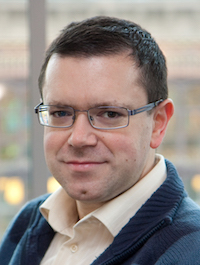NASA ADS
Google Scholar
MTMT (in Hungarian)
Citation metrics in ADS Bumblebee

Using microlensing observations of the Magellanic Clouds, he opened a new chapter in red giant asteroseismology by discovering short-period and low-amplitude pulsations in first-ascent red giant stars. Contrary to the then-current theoretical models, he showed that evolved, shell-hydrogen burning stars undergo global oscillations in high-overtone modes, with no measurable metallicity dependence (Kiss & Bedding 2003, 2004). He was first to demonstrate that the tight period-luminosity relations of red giant stars can be used to measure the three-dimensional structure of nearby dwarf galaxies. His results have been used to interpret velocity variations (T. Lebzelter, Univ. of Vienna; K. Hinkle, NOAO), calibrate period-luminosity relations (M. Feast, Univ. of Cape Town), study stellar structure and evolution (A. Zijlstra, UMIST; J. Christensen-Dalsgaard, Univ. of Aarhus), investigate Long Secondary Periods (P. Wood, ANU) and interpret multiple periodicity in other types of stars (J. Percy, Univ. of Toronto).
Over the last couple of years, he expanded his research into transiting exoplanets and exomoons (i.e. moons around exoplanets), supervising several postdocs and PhD students. They have investigated the possibility of detecting exomoons, and developed new methods to experimentally determine the density of these satellites (Simon et al. 2010, 2012). Using the ultra-precise observations of the Kepler space telescope, they were the first to detect and successfully explain observational signatures of orbital obliquity of a transiting substellar object around a rapidly rotating star (Szabó et al. 2011, 2012, 2014). With Kepler, his group also discovered a triply eclipsing triple system that consists of two red dwarf stars and an oddly quiescent red giant in which oscillations are strangely suppressed (Derekas, Kiss et al., Science, April 8, 2011). In subsequent studies, they developed a new theory of tidally-induced oscillations in red giants (Fuller et al. 2013) and measured the absolute masses and orbital geometry from the Kepler photometry alone (Borkovits et al. 2013).
Since 2012, Prof. Kiss has been heavily involved in space research activities, most notably as member of the Swiss-led CHEOPS Consortium, which aims at building the first S-Mission of the European Space Agency. Prof. Kiss has built new collaborations between the space industry in Hungary and the research organizations, leading to new contracts with those and ESA. His group is responsible for developing an observing strategy for the CHEOPS space telescope that is optimized for the detection of hypothetic satellites of exoplanets. In addition, they became member of the PLATO Consortium, which is building a new generation space telescope for exoplanets as the ESA M-mission to be launched in 2024.
Key scientometric indicators and international standing. The NASA Astrophysics Data System contains more than 400 publications by Prof. Kiss, with over 4,000 citations (of these, 144 papers appeared in refereed journals with ISI impact factors). The h-index is 34. His yearly citation rates show an upward trend, with 500 citations in 2013, 530 citations in 2014 and over 600 citations in 2015. Given the publication and citation characteristics in his research areas, the average publication rate of 8-10 refereed papers per year and the citation rates indicate an excellent standing in the international community. His core-collaborations include researchers from Hungary, Australia, United States, Canada, France, Denmark, Great Britain, Germany, Spain, Belgium, Austria, Chile and Italy. Through these collaborations Prof. Kiss has access to world-leading instruments, such as the ESO Very Large Telescope and its interferometer, the Anglo-Australian Telescope, the 6.5m Magellan telescopes, the 8.2m Gemini telescopes, and the SUSI and CHARA optical interferometers. Prof. Kiss is the Hungarian representative and elected Vice-Chair of the Board of Directors of the European journal Astronomy and Astrophysics. From 2016, Prof. Kiss will be the Hungarian science representative of the ESA Science Programme Committee, which is the highest level ESA body for selecting and overseeing future space projects.
